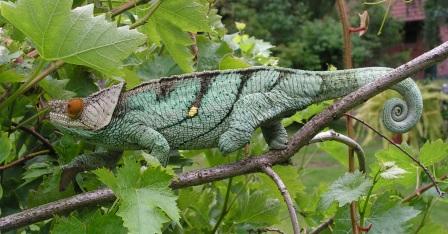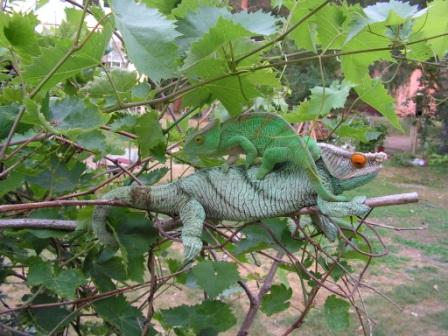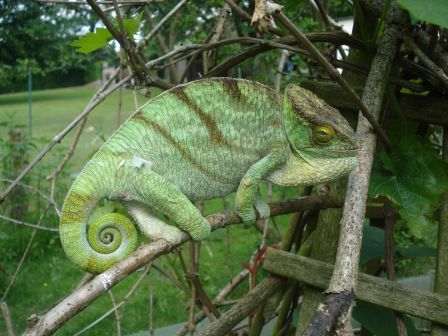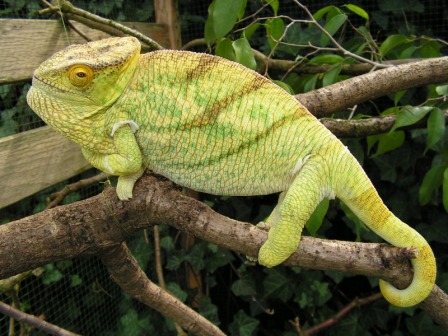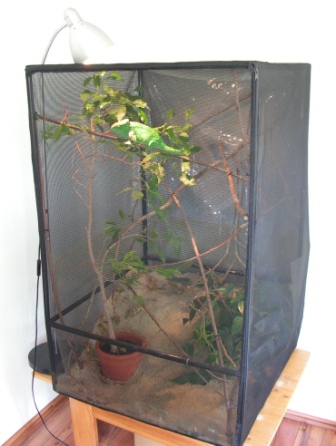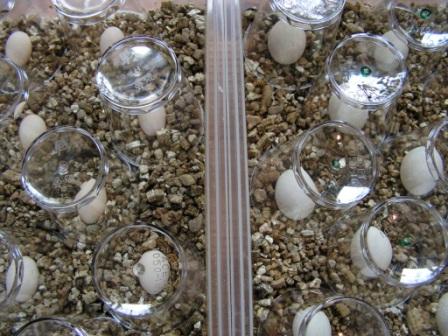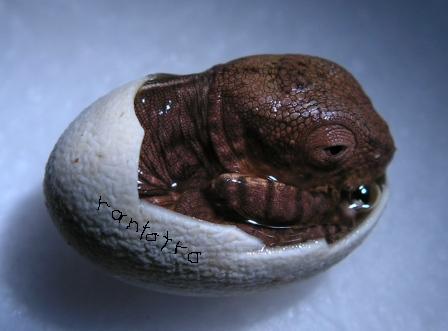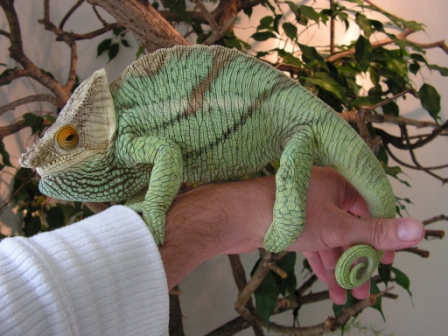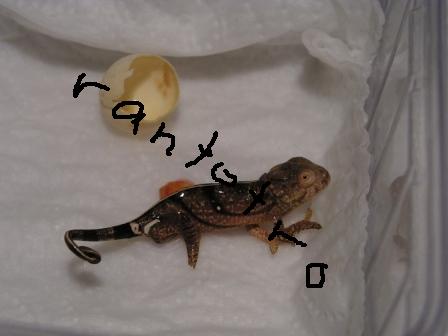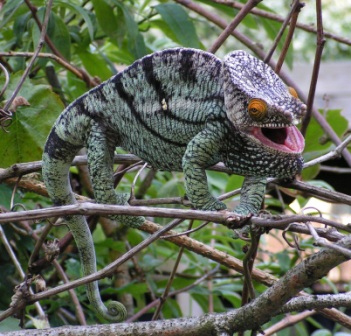Navigation
Install the app
How to install the app on iOS
Follow along with the video below to see how to install our site as a web app on your home screen.
Note: This feature may not be available in some browsers.
More options
You are using an out of date browser. It may not display this or other websites correctly.
You should upgrade or use an alternative browser.
You should upgrade or use an alternative browser.
Calumma parsonii parsonii
- Thread starter rantotro
- Start date
rantotro
Established Member
Beautiful pics and chameleons. I hope these are the parents from mine!
Hi Mark,
the father of your juveniles is Henry and the mother is Heike.
Here is a pic of Henry.
Attachments
Chameleonmaster
Avid Member
You have some beautiful chameleons right here
Motherlode Chameleon
Chameleon Enthusiast
Theyre CB. I cant seem to find any pics of green giants anywhere on the net for some reason, Im not convinced thats what they are, they look like orange eye to me!
There is a link to a couple of Photos on the Parsonii Forums. Green Giants are from the Masoala peninsula.
Here's a link. The pictures are in the wildlife section.
http://www.masoalaforestlodge.com/
Last edited:
rantotro
Established Member
I never have seen a mating before july. I think the females are waiting for the moment when the duration of the daylight takes down again in summer.
But the males don't try a violent mating like F.pardalis. They seem to know that they can't be successful without the support of the females for the copulation.
So they are waiting until they get their chance and treat the females gentle.
But the males don't try a violent mating like F.pardalis. They seem to know that they can't be successful without the support of the females for the copulation.
So they are waiting until they get their chance and treat the females gentle.
Attachments
OldChamKeeper
Chameleon Enthusiast
I never have seen a mating before july. I think the females are waiting for the moment when the duration of the daylight takes down again in summer.
But the males don't try a violent mating like F.pardalis. They seem to know that they can't be successful without the support of the females for the copulation.
So they are waiting until they get their chance and treat the females gentle.
I would agree with this, out of the many species I've kept I noticed early on that the Male Parson's was considerably "nicer" around females than other types of chameleons. Been a long time since I had one of these wonderful critters.
rantotro
Established Member
I have noticed that our females are receptive only in July or August for round about one week. When this week comes depends from the seasons in this year.
But short before and after this week they can be very angry against the males and change to yellow when they see them head bobbing.
So the male has up to three or four shots in this week. Maybe more if he is a very potent guy.
But short before and after this week they can be very angry against the males and change to yellow when they see them head bobbing.
So the male has up to three or four shots in this week. Maybe more if he is a very potent guy.
Attachments
rantotro
Established Member
But this week counts from the moment of the first fertilization.
If the female don't find a fertilizer maybe the period of reception is longer.
From the mating to egglaying the pregnancy needs round about 5 months. Also four up to six months are possible.
We keep the female seperate all this time. In a cage with a thick mesh she gets the shelter that she is needing now. When she is staring at other animals in the room despite of this mesh we hang cloth over her cage.
The soil we are using for egglaying is sand. But we are watering the sand so that it is humid enough for digging.
If the female don't find a fertilizer maybe the period of reception is longer.
From the mating to egglaying the pregnancy needs round about 5 months. Also four up to six months are possible.
We keep the female seperate all this time. In a cage with a thick mesh she gets the shelter that she is needing now. When she is staring at other animals in the room despite of this mesh we hang cloth over her cage.
The soil we are using for egglaying is sand. But we are watering the sand so that it is humid enough for digging.
Attachments
Benton1576
New Member
There is a link to a couple of Photos on the Parsonii Forums. Green Giants are from the Masoala peninsula.
Here's a link. The pictures are in the wildlife section.
http://www.masoalaforestlodge.com/
I knew it! He doesnt have green giants. His are orange eye as I thought. They look nothing like any of the green giants in the few photos I have managed to find.
Andreas,
Your Parsons are amazing and your knowledge of the species is the best. In a week or 2 if you dont mind, I will post photographs here of the babies I bought from you in September. Do you still have my reservation for another 2 from the different parents in September this year?
rantotro
Established Member
Hi Mark,
yes I've got your reservation. The father of the babies this year is Winfried.
So they are half siblings to your first two, like I have told you last year.
At the moment I have only three babies.
But Heike has laid this clutch on January 26 in 2011, her latest clutch ever. So the rest of the eggs have time a month. It has depended from her latest mating in August 2010. It was a cold year here in north germany.
yes I've got your reservation. The father of the babies this year is Winfried.
So they are half siblings to your first two, like I have told you last year.
At the moment I have only three babies.
But Heike has laid this clutch on January 26 in 2011, her latest clutch ever. So the rest of the eggs have time a month. It has depended from her latest mating in August 2010. It was a cold year here in north germany.
Action Jackson
Chameleon Enthusiast
Yes, thank you for sharing your knowledge and your great pictures. Also thank you for the help you've provided via PMs.
rantotro
Established Member
After the pregnancy period we are at a very critical point for the females, the egglaying.
The females are extreme shy when they look for the best place to deposit their biggest treasure, the eggs.
They stop digging every time when they see me around their cage. So I never had the chance to take a picture of this procedure. I didn't want to disturb them.
This shy behavior is natural to hide the eggs for predators, who are always around on madagascar.
Other reptiles or animals in the room could also disturb them, so that sometimes we have to hang cloth over the cage.
But there could be another problem additional I want to tell you.
You have read in this thread from the depending of the reproduction of this species from the seasons.
But the seasons on madagascar in the southern hemisphere are completely the opposite to the seasons in the northern hemisphere, where the most of us are living.
So there is no easy way to get them used to our seasons in a short time if they has grown up in the southern hemisphere on madagascar.
This could be a very big handicap for wc or maybe farm bred females because the eggs maybe grow a too long time before egglaying. On the picture you can see a comparison between fresh laid and one year old eggs.
I think this is the main reason why there are so less real cb animals of this species and so many females die with an egglaying problem.
Please think on this if you see a C. parsonii female in your pet shop. Believe me, you don't want to see her die. But the trader wouldn't order the next one if he can't sell her. This deadly circle has to stop.
There is an easy way to recognize if it is a real cb from the northern hemisphere but you need to know the real date of birth for it.
Babies are hatching in summer, when they can get the most insects. And this is one of the reasons why the females are digging these eggs with an incubation period of 1,5 years in the winter.
So if it is born in south summer, mostly in January or February, you will know where this egg was laid.
Our Babies are hatching between May and September, when it's summer in the northern hemisphere. I know it is the same with other real breeders.
The females are extreme shy when they look for the best place to deposit their biggest treasure, the eggs.
They stop digging every time when they see me around their cage. So I never had the chance to take a picture of this procedure. I didn't want to disturb them.
This shy behavior is natural to hide the eggs for predators, who are always around on madagascar.
Other reptiles or animals in the room could also disturb them, so that sometimes we have to hang cloth over the cage.
But there could be another problem additional I want to tell you.
You have read in this thread from the depending of the reproduction of this species from the seasons.
But the seasons on madagascar in the southern hemisphere are completely the opposite to the seasons in the northern hemisphere, where the most of us are living.
So there is no easy way to get them used to our seasons in a short time if they has grown up in the southern hemisphere on madagascar.
This could be a very big handicap for wc or maybe farm bred females because the eggs maybe grow a too long time before egglaying. On the picture you can see a comparison between fresh laid and one year old eggs.
I think this is the main reason why there are so less real cb animals of this species and so many females die with an egglaying problem.
Please think on this if you see a C. parsonii female in your pet shop. Believe me, you don't want to see her die. But the trader wouldn't order the next one if he can't sell her. This deadly circle has to stop.
There is an easy way to recognize if it is a real cb from the northern hemisphere but you need to know the real date of birth for it.
Babies are hatching in summer, when they can get the most insects. And this is one of the reasons why the females are digging these eggs with an incubation period of 1,5 years in the winter.
So if it is born in south summer, mostly in January or February, you will know where this egg was laid.
Our Babies are hatching between May and September, when it's summer in the northern hemisphere. I know it is the same with other real breeders.
Attachments
Motherlode Chameleon
Chameleon Enthusiast
That's a really neat technique to separate and identify if the baby Parsonii are from the southern (CH from wild animals) or northern hemisphere (most captive Parsonii). Thanks for posting.
rantotro
Established Member
In this 1,5 years of incubation we simulate the changing temperatures like on Madagascar. We are starting with a winter period in january and go up to a temperature, what we have measured on Nosy Boraha island in the soil in 15 cm of depth. At this place where we had found a female before and it was between 23 and 24°C in the end of November. In December starts the raining season and so we use this as maximum temperature for incubating from March to November.
For the winter temperature we had made an experiment from 2006 to 2008 with our first clutch.
We had built two groups of eggs, one with a higher temperature of 17 to 18°C and another group with 13-14°C.
The babies of the first group were hatched from May to September within 5 months. But the babies with the lower temperatures were hatched from June to August within 3 month. Also they were a little stronger than their siblings from the first group.
So we only use this lower winter temperatures since this experience.
Here are pictures from 2 of these first babies and to what they was grown after years.
For the winter temperature we had made an experiment from 2006 to 2008 with our first clutch.
We had built two groups of eggs, one with a higher temperature of 17 to 18°C and another group with 13-14°C.
The babies of the first group were hatched from May to September within 5 months. But the babies with the lower temperatures were hatched from June to August within 3 month. Also they were a little stronger than their siblings from the first group.
So we only use this lower winter temperatures since this experience.
Here are pictures from 2 of these first babies and to what they was grown after years.
Attachments
Action Jackson
Chameleon Enthusiast
I have three females. I thought I would be able to keep them together in a large outdoor cage but that is not working out. They are very territorial. I have two in a space 8'x7'x7' they stay at opposite ends and rarely move. Yesterday I put one of the females I have been keeping inside in the outdoor cage so I could move her cage and she immediately ran over and started a fight.
They are very territorial. I have two in a space 8'x7'x7' they stay at opposite ends and rarely move. Yesterday I put one of the females I have been keeping inside in the outdoor cage so I could move her cage and she immediately ran over and started a fight.
I will be dividing the outdoor cage and putting in a visual barrier soon.
I will be dividing the outdoor cage and putting in a visual barrier soon.
You have several males?
Is what they are separated or in the same room?
I have three male and I encounter the problem of bullying them. So I had to separate them.
rantotro
Established Member
You have several males?
Is what they are separated or in the same room?
I have three male and I encounter the problem of bullying them. So I had to separate them.
We keep all Parsons separate, even the babies.
Only in summer the females are sitting outdoors together for a few hours sometimes.
I July or August we build couples for mating. But even the couples are sitting together only for the mating. I want to control the real copulation with the binocular.
The males have visual barriers between. Otherwise there are too much visual fights between them and they are stressed too much. Their activity is unusual high and they are walking the whole day up and down on their branches. This can hurt their feet. Sometimes a visual fight is ok but not the whole day.
Similar threads
- Replies
- 20
- Views
- 4K

